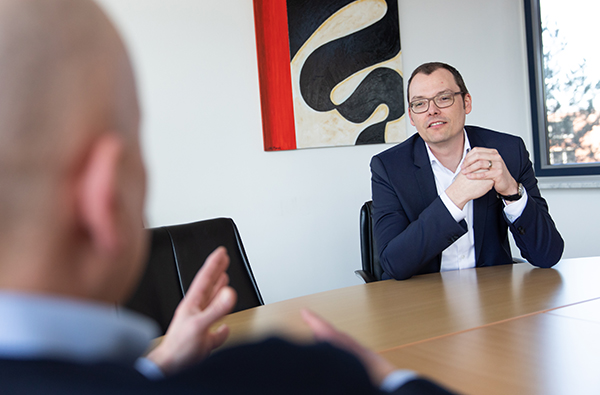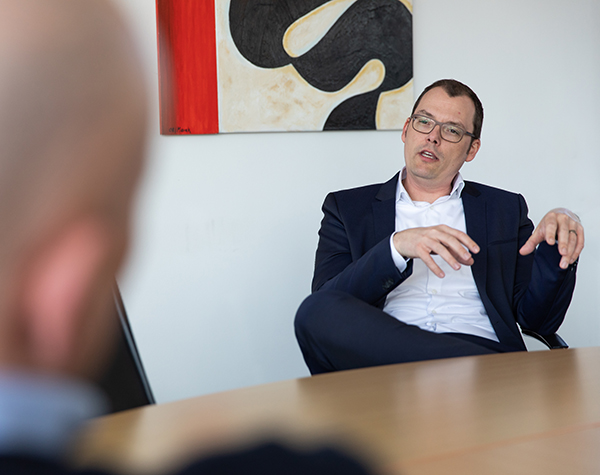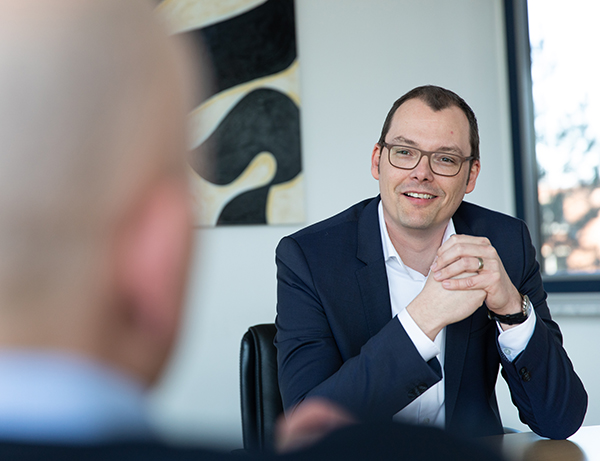
|
Software is the key to the future of the automotive industryAn interview with Philipp Hasenäcker Around a year ago, PROSTEP AG acquired a majority shareholding in Bartscher & Hasenäcker Consulting GmbH in order to enhance its expertise in the area of PLM/ALM for E/E (electrics/electronics) and software development. In this interview, Philipp Hasenäcker explains what E/E and software mean for PLM/ALM and what synergies he expects to achieve from working with PROSTEP. 
Question: Bartscher & Hasenäcker Consulting specializes in PLM/ALM for E/E and software. Was this your business model right from the start? Hasenäcker: Our current specialization was not originally an explicit business model. Instead, it has evolved over time. To start with, we were involved in a wide variety of PLM projects for a large carmaker, but we were always very close to the departments responsible for development. And it was here that we also became aware of the shortcomings in E/E and software development. The various organizational units for mechatronics development had their own custom processes and methods and the system landscape was extremely heterogeneous, having many isolated solutions that lacked a unifying framework. We then had the good fortune to be able to participate as external consultants in a major PDM project for E/E thanks to the expertise we already had in the OEM’s PLM toolchain and our sound reputation in the organization. We very quickly recognized that this was a crucially important issue for the future, and from that point on we focused all our energies on this area. Question: What is the significance of E/E and software in today's automotive industry? Hasenäcker: From long years of experience, all the major carmakers know how to produce high-quality, first-class mechanical products. Increasingly, however, the things that really make a difference are mechatronic assistance systems, smart features and, more recently, digital services and the fusion of the vehicle with its environment. It is a sign of the times that a highly innovative technology such as the MBUX multimedia system is first introduced in the A-Class rather than in the S-Class in order to attract new, digitally-minded target groups. As Daimler CIO Jan Brecht once said at the EDM Forum, the company must transform itself from a product-oriented to a service-oriented group, and software, whether as a component of mechatronic systems or in the form of digital services, will be the decisive driver for this transformation. Against this backdrop, I am firmly convinced that it is hardly possible to overstate the importance of E/E and software for the automotive industry. Question: Doesn't the amount of software in the vehicle sometimes scare you a little? Software is never free of errors and can be hacked. Hasenäcker: In my opinion, and the statistics back me up, the many different assistance systems have made driving significantly safer. In 2019, there were fewer fatalities on the roads than at any time since statistics began more than 60 years ago. Quite apart from that, we nowadays have few qualms about boarding a commercial aircraft in which the autopilot takes over a large part of the flight, using state-of-the-art avionics and highly complex software. Future success will undoubtedly crucially depend on whether we are able to master the heterogeneity in the development and management of software – over the entire lifecycle of vehicles. 
Question: What are the particular challenges in E/E and software development? Hasenäcker: To start with, the number of people involved in the development of mechatronic systems is much larger and more heterogeneous than in the traditional mechanical environment. The hardware developer, for example, usually doesn’t even know who is developing the software. There are complex supplier relationships and many different responsibilities, and all of these combine to ultimately ensure that the system functions robustly and consistently. This results in a considerable level of complexity that has to be managed in one way or another. Question: What are the concrete challenges regarding PLM? Hasenäcker: In our experience, one of the core challenges is compatibility management, in order to make potential conflicts transparent for all parties involved at all times. We are talking about networked mechatronic systems with many dependencies that have to be compatible with each other both internally and externally. The whole issue of traceability is another challenge. It must be possible to trace back the huge volume of information in mechatronic systems and components, and it all needs to be documented and versioned along the lifecycle. It is no secret that software develops far faster than, for example, the housing of an ECU or the PCB. An unbroken traceability chain continues to be an essential aspect of verification and certification processes, and it becomes all the more important the more the industry considers highly automated or autonomous driving as of level 3 and higher. Question: Why are there still no suitable IT systems available for this? Have PLM vendors been caught napping? Hasenäcker: PLM vendors will undoubtedly disagree, but I do not see PLM as a monolithic system, but rather as a composite made up of processes, methods and ancillary IT applications. The challenge in such a scenario is to combine traditional PLM and ALM capabilities and functionalities. ALM (application lifecycle management) has to be tightly integrated in this environment in order to manage the software artifacts appropriately. The interface between ALM and PLM is highly individual. In other words, a custom solution is always needed for the customer’s particular ecosystem, product profile and requirements. Question: What kind of solutions do you develop in customer projects? Hasenäcker: Our approach involves first working with the customer to build a joint understanding at the level of business processes in order to reveal the heterogeneous nature of the company’s operations. In a second step, we make use of our experience and best practices to help the customer design the actual solutions. In other words, we are not simply process consultants: Our proposals go far deeper, encompassing concepts and specifications, right down to the attribute level in the data models of affected IT applications. The only thing we do not do ourselves is realizing the software for the IT applications. In this area, we work together with partners and now, of course, also with PROSTEP. Question: So you design integrated tool chains for E/E and software based on the process requirements and the IT systems used? Hasenäcker: That’s right. We are particularly concerned with the integration of existing applications and the way they communicate with each other and exchange information. However, custom software is also used in a significant number of our projects because there are no suitable off-the-shelf solutions. Incidentally, the PDM project for E/E mentioned above also resulted in a fully customized software application. 
Question: So the PDM project on E/E for a carmaker has been your most important customer project to date? Hasenäcker: Yes, I think that's fair to say. The project provided huge impetus for us because we were able to have a positive impact in some development domains. As a result, we are now at home in the entire field of E/E and software management, with a clear focus on all software artifacts that are in some way significant for the ECUs. And we are extensively involved in the design of E/E release management. This is a core E/E integration process that ensures that up-to-date versions of E/E components, complete with hardware and software information, are made available for testing and validation in a coordinated way at defined points in the vehicle development process. Question: What synergies are you hoping to achieve together with PROSTEP? Hasenäcker: Up to now, our biggest challenge has been our focus on a single large carmaker. We hope that working with PROSTEP will enable us to acquire new customers and projects in the automotive and other industries, as the company is a highly respected partner for PDM and PLM throughout Germany and beyond. We are working together intensively to firmly establish our range of solutions for E/E and software in the PROSTEP Group so that we can use the enhanced profile to acquire new customers or address new fields with existing customers. Question: Is this already making a noticeable difference to day-to-day business? Hasenäcker: At operational level, there are already a number of projects in which we are bundling our strengths. For example, we had a contract to develop a solution for extended functional testing in the field of E/E in which we brought PROSTEP on board as a development partner. The staff at the Polish location programmed the software for us so that we were able to offer the customer an overall solution from one provider. And there are already two joint projects for another large OEM in which we want to become more deeply involved in the future. Together with colleagues from PLM strategy consulting, we have also expanded the capability landscape to include E/E-specific aspects so that it can also be used when dealing with questions relating to mechatronic products. Question: Are you also involved in the subsidized projects for the digital validation of autonomous driving functions, in which PROSTEP is playing an important role? Hasenäcker: Up to now, our involvement has only been peripheral, but we have already taken steps to intensify our collaboration in this area as well. I attach great importance to these projects because we need common standards for autonomous driving. Standards are essential if German carmakers and suppliers want to continue to be strong in the future. Mr. Hasenäcker, thank you very much for talking to us. (This interview was conducted by Michael Wendenburg) 
Philipp Hasenäcker (born in 1980) heads up Bartscher & Hasenäcker Consulting GmbH (BHC) in Böblingen, which is part of the PROSTEP Group. Hasenäcker hails from Paderborn and studied industrial engineering in Detmold. He has been working as an external consultant for PLM/ALM for E/E and software in the automotive industry for more than 15 years. Since 2016 he has been co-owner and managing director of BHC. |
|
| © PROSTEP AG | ALL RIGHTS RESERVED | IMPRESSUM | DATENSCHUTZERKLÄRUNG | HIER KÖNNEN SIE DEN NEWSLETTER ABBESTELLEN. |
